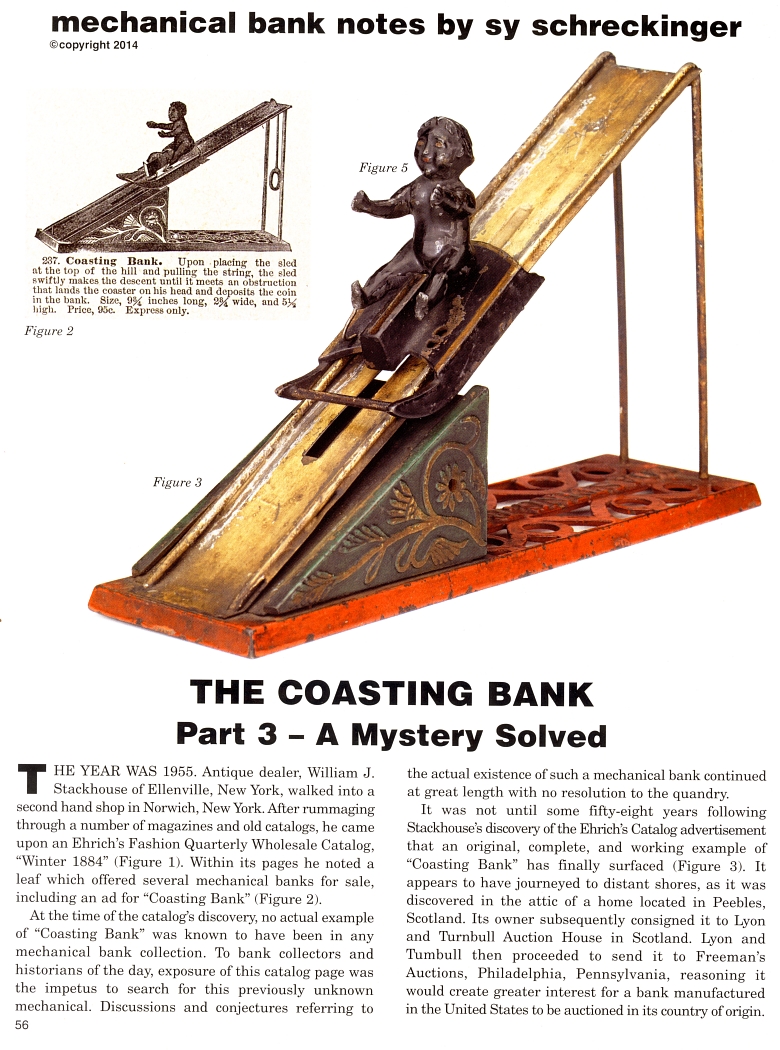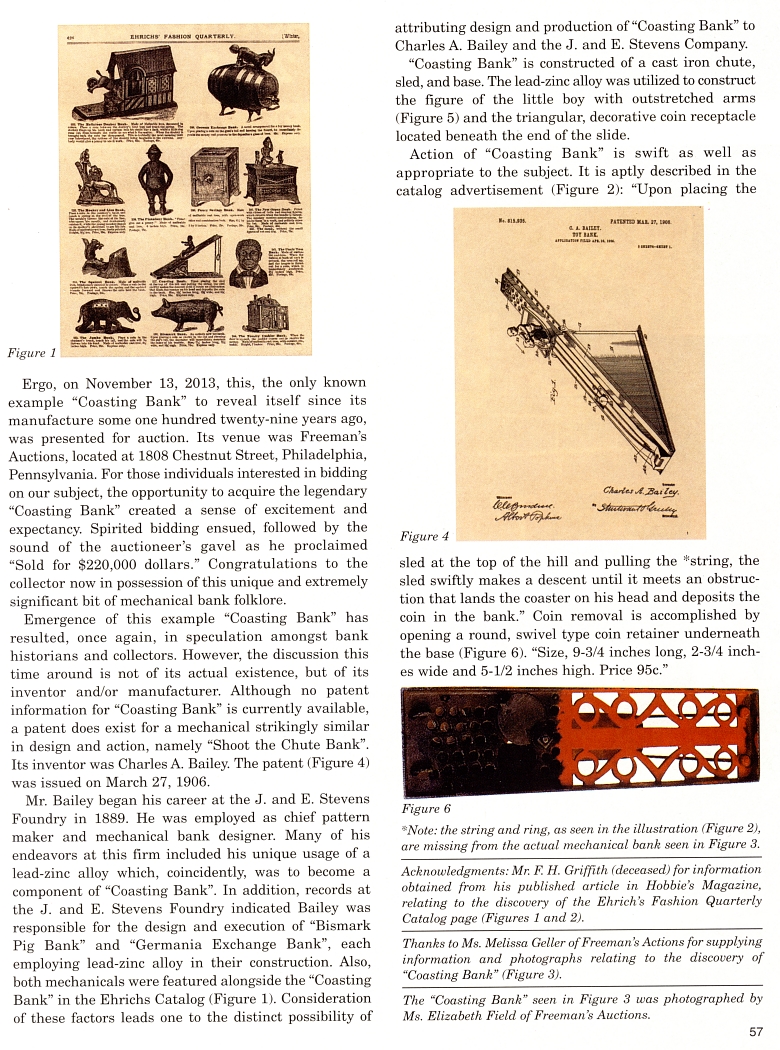|
The Coasting Bank,
Part 3 - A Mystery Solved
by Sy Schreckinger – ANTIQUE TOY WORLD Magazine – January, 2014
THE YEAR WAS 1955. Antique dealer, William .J. Stackhouse of Ellenville,
New York, walked into a second hand shop in Norwich, New York. After
rummaging through a number of magazines and old catalogs, he came upon
an Ehrich's Fashion Quarterly Wholesale Catalog, "Winter 1884" (Figure
1). Within its pages he noted a leaf which offered several mechanical
banks for sale, including an ad for "Coasting Bank" (Figure 2).
At the time of the catalog's discovery, no actual example of
"Coasting Bank" was known to have been in any mechanical bank
collection. To bank collectors and historians of the day, exposure of
this catalog page was the impetus to search for this previously unknown
mechanical. Discussions and conjectures referring to 56 the actual
existence of such a mechanical bank continued at great length with no
resolution to the quandary.
It was not until some fifty-eight years following Stackhouse's
discovery of the Ehrich's Catalog advertisement that an original,
complete, and working example of "Coasting Bank" has finally surfaced
(Figure 3). It appears to have journeyed to distant shores, as it was
discovered in the attic of a home located in Peebles, Scotland. Its
owner subsequently consigned it to Lyon and Turnbull Auction House in
Scotland. Lyon and Turnbull then proceeded to send it to Freeman's
Auctions, Philadelphia, Pennsylvania, reasoning it would create greater
interest for a bank manufactured in the United States to be auctioned in
its country of origin.
Ergo. on November 13, 2013, this, the only known example "Coasting
Bank" to reveal itself since its manufacture some one hundred
twenty-nine years ago, was presented for auction. Its venue was
Freeman's Auctions, located at 1808 Chestnut Street, Philadelphia,
Pennsylvania. For those individuals interested in bidding on our
subject, the opportunity to acquire the legendary "Coasting Bank"
created a sense of excitement and expectancy. Spirited bidding ensued,
followed by the sound of the auctioneer's gavel as he proclaimed "Sold
for $220,000 dollars.' Congratulations to the collector now in
possession of this unique and extremely significant bit of mechanical
bank folklore.
Emergence of this example "Coasting Bank" has resulted, once again,
in speculation amongst bank historians and collectors. However, the
discussion this time around is not of its actual existence, but of its
inventor and/or manufacturer. Although no patent information for
"Coasting Bank" is currently available, a patent does exist for a
mechanical strikingly similar in design and action, namely "Shoot the
Chute Bank". Its inventor was Charles A. Bailey. The patent (Figure 4)
was issued on
March 27, 1906.
Mr. Bailey began his career at the J. and E. Stevens Foundry in
1889. He was employed as chief pattern maker and mechanical bank
designer. Many of his endeavors at this firm included his unique usage
of a lead-zinc alloy which, coincidently, was to become a component of
"Coasting Bank". In addition, records at the J. and E. Stevens Foundry
indicated Bailey was responsible for the design and execution of "Bismark
Pig Bank" and "Germania Exchange Bank", each employing lead-zinc alloy
in their construction. Also, both mechanicals were featured alongside
the "Coasting Bank" in the Ehrichs Catalog (Figure 1). Consideration of
these factors leads one to the distinct possibility of attributing
design and production of "Coasting Bank" to Charles A. Bailey and the J.
and E. Stevens Company.
"Coasting Bank" is constructed of a cast iron chute, sled, and
base. The lead-zinc alloy was utilized to construct the figure of the
little boy with outstretched arms (Figure 5) and the triangular,
decorative coin receptacle located beneath the end of the slide.
Action of "Coasting Bank" is swift as well as appropriate to the
subject. It is aptly described in the catalog advertisement (Figure 2):
"Upon placing the sled at the top of the hill and pulling the *string,
the sled swiftly makes a descent until it meets an obstruction that
lands the coaster on his head and deposits the coin in the bank." Coin
removal is accomplished by opening a round, swivel type coin retainer
underneath the base (Figure 6). "Size, 9-3/4 inches long, 2-3/4 inches
wide and 5-1.12 inches high. Price 95c."
*Note: the string and ring, as seen in the illustration (Figure 21,
are missing from the actual mechanical bank seen in Figure 3.
Acknowledgments: Mr. F H. Griffith (deceased) for information
obtained from his published article in Hobbies Magazine, relating to the
discovery of the Eli Fashion Quarterly Catalog page (Figures 1 and 2).
Thanks to Ms. Melissa Geller of Freeman ' Actions for supplying in
formation and photographs relating to the discovery of toasting Bank"
(Figure 3).
The toasting Bank" seen in Figure 3 was photographed by Ms.
Elizabeth Field of Freeman's Auctions. |


